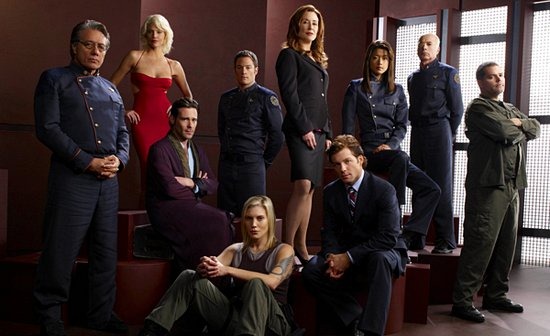Continued from the last post.
Stylistically, the series often doesn’t feel very futuristic. In too many sci-fiction series, problems typically get resolved through very fantastic and sci-fi ways. BSG doesn’t rely on technological mumbo jumbo as cop-outs. Instead, the series tries to ground itself in our reality. For example, the main center of operations (the bridge) in shows like the recent Star Trek film looks like an Apple storefront and too fake. In BSG, the command center looks like a bridge of a working aircraft carrier with wires, screens, vents, computer printers, switches everywhere – and it’s operated by dozens of personnel each manning their individual watch stations. It looks organic, functional, and exactly like the kind of frenetic military ops center where real planning, strategizing and in-operation control take place.

The realistic approach to creating the series’ fictional universe extends even to world elements that are the staple of sci-fiction shows. Specifically, there are no lasers, phasers, photon torpedoes, or light sabers to be found anywhere. Rather, the offensive weapons comprise stuff that already exists in the real world: bullet projectiles, missiles, and nuclear bombs. I admit it was a little jarring when I first watched the opening episodes in 2003 of space dogfights being fought by maneuverable craft firing mass accelerator cannons instead of laser bolts that go ‘pew pew’, but one gets used to it real quick. The one concession that’s made are the faster-than-light jumps, which is the series’ warp/hyperspace equivalents. But at least the jump activity in the show is a lot more involved in execution than in shows like Star Trek where warps are executed by the mere flick of a switch.
—
The cast and the incredible portrayal of characters is also one of the main draws. Arguably the lead and most important character in the series is Adama (Edward James Olmos, left in the picture), an old and seasoned veteran with sardonic wit, and the commander of the Galactica. He’s terrifically economical in his choice of words; concise but yet always decisive. I’m thinking of similar characters in films whose spoken dialog performances are as mesmerizing, and I’ll put Olmos’ Adama between Colonel Hans Landa and Hannibal Lector.
Opposite him is Laura Roslin, played by Mary McDonnell (standing, center) who’s likely most remembered for her role as ‘Stands with a Fist’ in Kevin Costner’s Dances with Wolves. Roslin is the one-time Secretary of Education, a relatively low government official in the political pecking order, but finds herself thrust into the position of President when everyone else in front of her is wiped out in the Cylon massacre.

One of the earliest dilemmas that establishes the tone of the remainder of the series was seen in the first episodes. When Adama gets his bearings after the initial Cylon assaults, his agenda is to take his warship into the fight – regardless of whether any of the other hundreds of similar warships in the human naval armada have survive (as we find out later, only one other did). Roslin’s agenda on the other hand is to run. As far as she’s concerned, humanity has lost and the only thing left for them to do was to gather the survivors, and flee – which would still be suicidal unless her civilian fleet that hold all that remains of humans (all 49,000 of billions initially) is protected by the only warship left around, the Galactica.
Concluded in the next post.

Recent comments